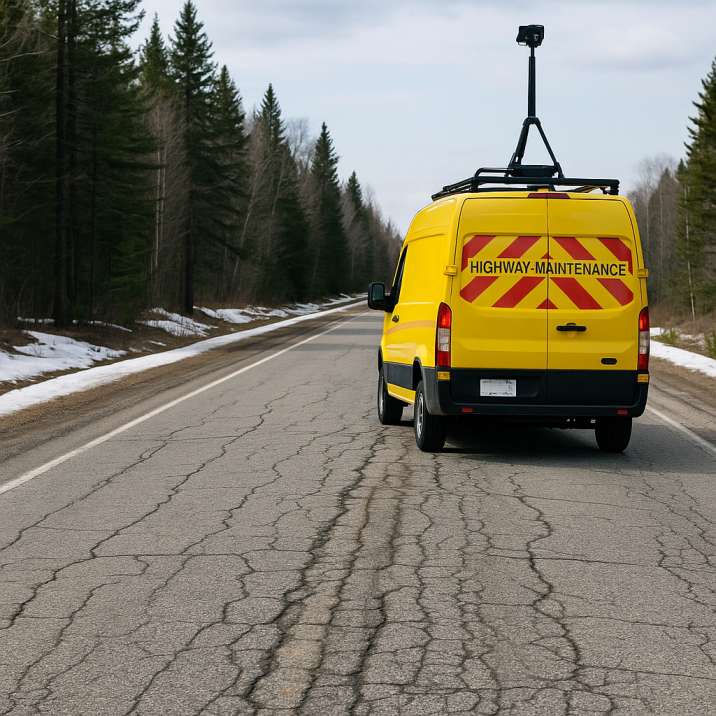Contact Us
RoadVision AI
Private Limited
Office No. 308 & 310, B Block
Ansal Chamber - 1, Bhikaji Cama Place,
Near Engineers India Limited (EIL) Bhawan, New Delhi - 110066
© 2024 | RoadVision AI | All rights reserved
Canada’s vast and climate-diverse road network is exposed to extreme temperatures, freeze-thaw cycles, and high traffic loads. These factors contribute significantly to pavement distress, a key concern in AI road asset management across Canadian provinces. From pavement cracks to rutting, untreated road damage results in safety hazards, increased maintenance costs, and deteriorated public infrastructure.
As provincial and municipal governments work to uphold the TAC Pavement Asset Design and Management Guide and Transport Canada’s Infrastructure Framework, there is a growing need for automated pavement condition monitoring. In this blog, we explore the most common pavement distresses in Canada, how they are traditionally assessed, and how AI-based pavement distress detection tools like RoadVision AI are transforming road inspection and management.

Pavement cracking is one of the earliest indicators of deterioration. It typically falls under four categories:
These pavement cracks in Canada are accelerated by freeze-thaw cycles, especially in Ontario, Quebec, Alberta, and Northern provinces where climate-induced stress is severe.
Rutting is a surface depression in the wheel paths, caused by consolidation or lateral movement of pavement materials. It compromises road safety by causing water accumulation, increasing the risk of hydroplaning. Rutting detection is critical in urban highways and high-volume corridors.
Potholes occur when moisture penetrates through cracks, weakening the base layers. During winter, the freeze-thaw cycle expands the cracks, and traffic stress eventually breaks the surface. Potholes cause serious damage to vehicles and increase maintenance liabilities.
Raveling is the progressive disintegration of surface material due to loss of aggregate and binder. It leads to roughness and decreased skid resistance, especially dangerous in high-speed zones and rural highways.
Common on intersections or roads with frequent stopping, shoving appears as a wave-like pattern due to unstable mixes. Corrugation is similar but more repetitive. These reduce ride quality and can damage vehicles.
Canadian agencies traditionally rely on manual road surveys, visual inspections, and ride quality measurements using pavement condition index (PCI) systems. While PCI is widely adopted in municipalities, this method:
This leads to delayed maintenance, inaccurate road asset management, and inefficient capital planning.
With the advent of AI road asset management, cities and infrastructure departments now have access to faster, more accurate, and scalable pavement condition insights.
AI models, trained on millions of road images, can now identify, classify, and measure all types of pavement cracks automatically. Unlike manual surveys, AI ensures consistent and real-time detection regardless of location or weather conditions.
Platforms like RoadVision AI can capture video data through smartphones or mounted cameras and analyze cracks with pixel-level precision.
Using depth estimation and image-based sensors, AI can detect rutting by identifying wheel path depressions and estimating depth profiles. This helps cities proactively schedule preventive maintenance, avoiding major failures.
Tools like RoadVision’s Pavement Condition Survey digitize and automate PCI scoring, integrating it with pavement distress data, asset geolocation, and predictive models. This enables a dynamic, continuously updated view of road health.
AI systems also integrate with road inventory inspection databases, allowing for seamless asset tracking — including signs, signals, culverts, and road segments — tagged with corresponding distress levels and maintenance history.
With the integration of traffic survey data, AI can correlate distress patterns with vehicle load, speed, and frequency, enabling smarter asset lifecycle management. For instance, roads with high heavy truck volume can be prioritized for rutting analysis and resurfacing.
Canada’s Ministry of Transportation and the Transportation Association of Canada (TAC) provide frameworks for pavement assessment, and several provinces have adopted automated tools in pilot studies. As Smart Cities Canada and Infrastructure Canada fund AI-driven initiatives, adopting solutions like RoadVision AI aligns with national priorities around digital transformation and climate-resilient infrastructure.
Canadian road authorities are now moving toward smarter, data-driven approaches for managing road infrastructure. With climate pressure, growing populations, and aging roads, adopting AI for pavement distress detection is no longer optional — it's essential.
RoadVision AI is transforming infrastructure development and maintenance by harnessing AI in roads to enhance safety and streamline road management. Using advanced roads AI technology, the platform enables early detection of potholes, cracks, and surface defects through precise pavement surveys, ensuring timely maintenance and optimal road conditions. Committed to building smarter, safer, and more sustainable roads, RoadVision AI aligns with both IRC Codes and Canadian road engineering standards, empowering engineers and stakeholders with data-driven insights that cut costs, reduce risks, and enhance the overall transportation experience.
Explore how RoadVision AI can help your city or department monitor and manage road conditions more intelligently.
Book a demo with us and take the first step toward smarter road asset management in Canada.
Q1. What is the most common pavement distress in Canada?
The most common types are longitudinal and transverse cracks, followed by rutting and potholes, especially in freeze-thaw regions.
Q2. How accurate is AI in detecting pavement cracks?
AI models can detect and classify cracks with over 90% accuracy using computer vision and deep learning.
Q3. Is PCI still used if AI is adopted?
Yes, AI systems like RoadVision enhance and automate PCI reporting, not replace it, making condition monitoring more scalable and objective.